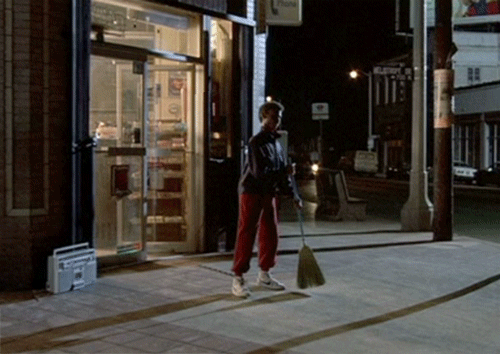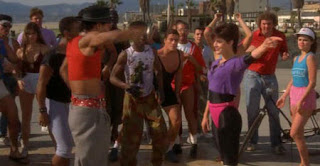 FILM:
FILM:Breakin' 2: Electric Boogaloo - 1984
See link for writing credits
Directed by Sam Firstenberg
With Adolfo "Shabba-Doo" Quinones, Michael "Boogaloo Shrimp" Chambers & Lucinda Dickey
 When Golan & Globus managed to beat Beat Street to theaters with Breakin', it became the first break dancing movie and a huge success for Cannon Films. Never one to leave perfectly good money laying around, Menahem Golan immediately ordered a sequel, and had it to theaters in seven months' time. That's right, both Breakin' and Breakin' 2 were released in 1984. Of course, even if you've never seen Breakin' 2, you still remember it for one of the most legendary film titles in cinematic history; Electric Boogaloo. No one knows what it is (including the stars), but it's all over the sequel.
When Golan & Globus managed to beat Beat Street to theaters with Breakin', it became the first break dancing movie and a huge success for Cannon Films. Never one to leave perfectly good money laying around, Menahem Golan immediately ordered a sequel, and had it to theaters in seven months' time. That's right, both Breakin' and Breakin' 2 were released in 1984. Of course, even if you've never seen Breakin' 2, you still remember it for one of the most legendary film titles in cinematic history; Electric Boogaloo. No one knows what it is (including the stars), but it's all over the sequel.
Now, Breakin' was not a great movie. It was totally formulaic and had some culturally tone-deaf production elements, but it served its purpose well as an introduction to the world of hip-hop dance. My abiding impression of Breakin' was that it would have benefitted from a streamlined story and more dancing.
Breakin' 2: Electric Boogaloo listened to the desires that people surely must have had from the first, and then makes them regret it.
While I declared Breakin' to have the story of "every dance movie ever" it turns out that Breakin' 2 has an even older formula; The Big Show. A bunch of free-spirited and idealistic young people (including our returning heroes) determine to "put on a show" to save their community center. There's still some "You don't understand my art! You never supported me!" melodrama with Kelly and her super-WASPy rich parents.
There are also the romantic sub-plots, for both good and ill. Kelly and Ozone continue their painfully awkward hand-holding "romance." As if their inherent lack of chemistry weren't complicated enough, there's a tall drink of hairspray that reckons she should be Ozone's lady instead and means to chase Kelly (an outsider anyway) away. There is no reason to care about any of this, and it's just painful to even be reminded that we're pretending they work as a couple. Confidentially, if Ozone isn't dancing, he looks like he's upset about something he smelled. All that really comes out of this is a reason for Ozone to get angry about Kelly taking a job in France, which is another subplot that I didn't care about either.
Meanwhile, Turbo gets a love interest this time around too. He's gobsmacked by a young Latina dancer named Lucia, and although she evidently speaks no English, their limited amount of chemistry only highlights the agony of Kelly & Ozone's. We get more Turbo, thanks to this, and that just adds personality to the film. This is a big plus.
Unfortunately, there are just so many more minuses.

 Breakin' succeeded despite itself thanks to the dancing, even if it leaves us wanting much more. Breakin' 2 gives us more dancing. Sadly, it doesn't give us all that much more breaking. There is a LOT of dancing in Breakin' 2, but where the original had only flirted with clueless Hollywood floundering, the sequel fully embraces it. Dance numbers are filled with a great deal of skipping through the streets. They're much more designed as stage routines than authentic b-boyism. Despite having more dance overall, I feel fairly comfortable guessing that Breakin' 2 has less actual breakin' than the original. I was prepared to forgive all other categories if Electric Booglaoo simply had more of the kind of dancing that Breakin' had, but that's the problem. It's not the kind of dancing we came to see. There are nuggets of break dance in the other routines, but they play more like guest solos than a full revue. Despite being Ozone & Turbo's world, the dance is far more Kelly than it was before.
Breakin' succeeded despite itself thanks to the dancing, even if it leaves us wanting much more. Breakin' 2 gives us more dancing. Sadly, it doesn't give us all that much more breaking. There is a LOT of dancing in Breakin' 2, but where the original had only flirted with clueless Hollywood floundering, the sequel fully embraces it. Dance numbers are filled with a great deal of skipping through the streets. They're much more designed as stage routines than authentic b-boyism. Despite having more dance overall, I feel fairly comfortable guessing that Breakin' 2 has less actual breakin' than the original. I was prepared to forgive all other categories if Electric Booglaoo simply had more of the kind of dancing that Breakin' had, but that's the problem. It's not the kind of dancing we came to see. There are nuggets of break dance in the other routines, but they play more like guest solos than a full revue. Despite being Ozone & Turbo's world, the dance is far more Kelly than it was before.Which is not to say that there isn't ANY good dance. There's a good number where Ozone & Turbo fight over a "partner" and, as in the first movie, the show-stopper belongs to Turbo. This time, he break dances his feelings (with actual breaking moves) for Lucia in a number that calls back Fred Astaire, as he dances up the walls and spins on the ceiling. While this crowd-pleaser gives us a more generous high-concept dose of "Boogaloo Shrimp," it's counterbalanced by a painful and embarrassing "dance combat" number between rival dance crews. Electric Boogaloo is a heartbreaking example of old guys telling the kids what they're into rather than letting the kids just do their thing. What they needed to do: feature more break dancers. What they did; hired more Hollywood dancers.
The really obvious clue that Breakin' 2 was misdirected comes from the costumes. Breakin's costumes were highly stylized versions of era-appropriate fashion trends. Breakin' 2's costumes are an old man's reactions to youth culture. Almost everything is day-glo bright. If you've only read about the 80s, you might think that's normal, but the day-glo color trend really didn't happen until the late decade. This reminded me more of an episode of Batman I recently saw where Milton Berle plays a gangster manipulating a "Flower People" youth culture of comically dressed nitwits. It augments the screen impact, but it diminishes the cultural cache.
 The music in Electric Boogaloo follows much the same pattern as its other component parts. It's bigger, but it's worse and less appropriate. More radio poppy, less hip-hoppy. Ice-T returns for some reason, looking like he scored his wardrobe from a picked-over sale of Mad Max leftovers.
The music in Electric Boogaloo follows much the same pattern as its other component parts. It's bigger, but it's worse and less appropriate. More radio poppy, less hip-hoppy. Ice-T returns for some reason, looking like he scored his wardrobe from a picked-over sale of Mad Max leftovers.While Breakin' aims low and delivered a passably enjoyable artifact of early hip-hop culture, Breakin' 2: Electric Boogaloo tries to go for "more" in all the wrong ways. There IS some enjoyable dance, but it's buried under a pile of all the things that the sequel made worse through wrong-headed overreach.
In fact, I'm going to do you a favor. Here's Turbo's dance on the ceiling on YouTube. Please enjoy it at your leisure. Now you have no reason to mess around with Breakin' 2: Electric Boogaloo. Even when Golan & Globus had a good thing on their hands, they couldn't resist giving it the Anti-Midas Touch.



















